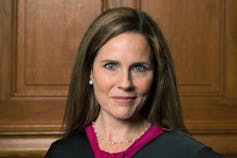What is charismatic Catholicism?
The Catholic charismatic movement in the United States began during the 1960s. The practices of Catholic charismatics encompass various forms of Pentacostalism.

Amy Coney Barrett reportedly will be Donald Trump’s nominee to replace Justice Ruth Bader Ginsburg on the Supreme Court.

Questions have been raised about her alleged association with the “People of Praise,” a nondenominational Christian charismatic community, seen by some as being a potential influence on her legal thinking, particularly concerning abortion rights.
The People of Praise leave it to individual members to disclose their affiliation, and Barrett has not spoken about her membership. And so, the question remains: What is charismatic Catholicism?
Pentecostalism in the U.S.
Catholic charismatics practice forms of Pentecostalism that embrace the belief that individuals can receive gifts of the Holy Spirit.
Modern Pentecostalism in the United States began on Azuza Street in Los Angeles.
Starting in 1909, African American pastor William J. Seymour led a congregation in the city that claimed to have received miraculous gifts from God, such as prophecy and the power to heal. The movement came to be known as Azuza Street revival.
Members of the Azuza Street congregation believed that they had been given the same blessings as those received by the disciples of Jesus. According to the Bible’s Acts of the Apostles, on the Pentecost – the Jewish Shavuot harvest festival 50 days after Passover – the Holy Spirit came down in the form of flames over the disciples’ heads. Afterward, it is believed, the disciples were able to speak in languages they did not know in order to proclaim “the wonders of God.”
In Christianity, the Holy Spirit is the third person of the Trinity and is associated with God’s action in the world.
The Catholic charismatic movement
These Pentecostal teachings went on to influence the Catholic charismatic movement that initially took hold in the U.S. in the 1960s.
During a 1967 prayer meeting at Dusquesne University in Pittsburgh, a group of students and professors spoke about special “charisms,” or gifts, received through the Holy Spirit.
According to firsthand accounts, faculty were deeply influenced by two books from the Pentecostal tradition, “The Cross and the Switchblade” and “They Speak with Other Tongues.”
Similar experiences of the Holy Spirit were later reported at prayer meetings at the University of Notre Dame and the University of Michigan.
From these beginnings, the Catholic charismatic movement has spread throughout the world.
For Catholic charismatics, the central experience is “the baptism of the Holy Spirit.” The baptism of the Holy Spirit differs from the traditional Catholic infant baptism with water. Adults baptized in the Holy Spirit have their faith reborn and strengthened by members of the congregation laying their hands on them.
Often a sign of baptism of the Holy Spirit is “glossolalia,” or “speaking in tongues.” Speaking in tongues refers to using an unintelligible language, which is often interpreted by someone else in the congregation. Usually glossolalia is considered a form of prayer. But other times, glossolalia is believed to contain prophecies about present or future events.
Participants in the Catholic charismatic movement also claim spiritual and physical healing associated with the power of the Holy Spirit working through believers.
Catholic charismatic prayer services are enthusiastic and involve energetic singing, hand clapping and praying with arms outstretched.
Controversy and support
There are also forms of charismatic Catholicism that believe in driving out evil spirits.
A Catholic charismatic community in India that I researched practiced exorcism as well as faith healing. The group also had a list of evil spirits that they claimed to have dealt with.
[Insight, in your inbox each day. You can get it with The Conversation’s email newsletter.]
Not all Catholic charismatic groups perform exorcisms, especially since the Vatican tightened exorcism procedures by allowing them to be formally performed only by priests. But Catholic charismatic practices remain controversial for some because they differ from mainstream Catholic worship.
Recently, Catholic charismatics have found a strong ally in Pope Francis. In fact, at Rome’s Olympic Stadium, the pope once knelt and was blessed by a gathering of thousands of Catholic charismatics, all speaking in tongues.
Commentators disagree about whether Barrett’s membership in a charismatic religious community should be an issue in any potential nomination hearings. But charismatic or Pentecostal groups and churches represent the fastest-growing segment of Christianity throughout the world. For this reason, Amy Coney Barrett’s beliefs may be shared by many contemporary Christians.
Mathew Schmalz received Fulbright and American Institute of Indian Studies dissertation grants for the study of charismatic Catholicism in India. Mathew Schmalz is a Roman Catholic and is registered as an Independent.
Read These Next
Miami’s new mayor faces a housing affordability crisis, city charter reform and a shrinking budget
Eileen Higgins won a hard-fought election to become Miami’s new mayor. Now for the hard part – governing…
Sharks and rays get a major win with new international trade limits for 70+ species
Sharks have had a tough time since the 1970s, when overfishing, habitat loss and a growing trade in…
‘Yes’ to God, but ‘no’ to church – what religious change looks like for many Latin Americans
Protestant churches’ growth in Latin America gets lots of attention, but another important shift is…






